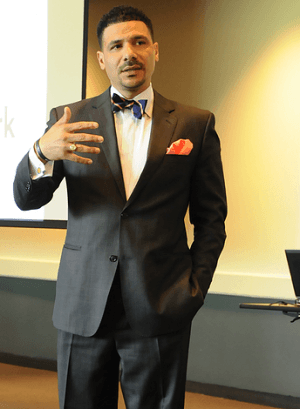
Education reexamined with the help of Dr. Steve Perry, Education Contributor for CNN
As we see it now, education happens weekdays from 8am to 3pm, on chalkboards, in heavy textbooks, in white-walled classrooms. There is not much wiggle room for other forms or perceptions of. But, of course, education in America is changing and this is nearly always the case. From desegregation efforts in the 1960s (through now) to the integration of Smartboards and Twitter into everyday learning, the way we teach has seen constant evolution.
Education is a slippery thing. It often starts with a question. What is 8 divided by 4? What is the preterite conjugation of the Spanish verb cantar? And so on. Questions like these are adequate predictors for success so long as you measure success as being able to grab hold of the next rung on the ladder. Ladder rungs are important, crucial even. But considering stairs, ramps, escalators, and elevators, we become aware that they are certainly not the only option.
According to a recent report by the US Department of Education, 24 million adults in the United States have low skills, scoring below Level 2 on the literacy assessment. It is true, then, that there are millions of adults in our workforce struggling to comprehend a technology-rich environment. “Raising skills can pay substantial dividends for individuals and families, business and industry, and communities at large,” the report finds. I recently spoke with Dr. Steve Perry, Education Contributor for CNN and MSNBC, to discuss the evolution of education and the positive influence of technology on illiterate Americans in our workforce. On the 3 million or so youth and adults who are already actively seeking an education, “They’re forced to think outside of the box because they don’t live in one,” Dr. Perry posits. “[A classroom setting] doesn’t provide them with the opportunity to improve skills in a comfortable setting.”
Technology is allowing for what Dr. Perry refers to as the “democratization of education.” When students (of all ages) feel connected to their coursework, and feel as though they have freely chosen to engage in certain material, the effects will be long-lasting. E-learning has changed the face of education for all ages, from Khan Academy (while targeted toward K-12 is offered to all), which offers free lessons over a host of subjects, to online degree programs like University of Phoenix, which offers flexible learning in multiple disciplines. Even the rise of massive open online courses (MOOCs) is a trend worth noting, although they are not a true alternative to obtaining a degree, as students do not tend to finish courses or take more than one at a time. These opportunities are nevertheless crucial to eliminating low literacy rates among adults in the United States.
In addition to alleviating the associated shaming/guilting of adults who wish to gain a degree “late in the game,” or even simply improve their reading skills, online learning diffuses classism and racism for all ages of learning. “Engaging technology can mitigate the impact of race,” Dr. Perry says, which coincides with his democratization of education. He argues that this is the case because of the anonymity online between teacher/computer and student. This is more difficult to show statistically, but it is nevertheless another benefit and trend present in the changing face of US education. While I cannot make claims that technology has directly improved lives by dissipating racial discrimination, it can’t hurt to try when, “Black, American Indian/Alaskan Native, Hispanic, and Asian/Pacific Islander adults [are] more likely than White adults to perform in the lowest two literacy levels,” according to a study by the National Center for Education Statistics.
In this report I’ve merely skimmed the surface of the deepening, widening definition of education in the United States. Educators such as Dr. Perry strive everyday to provide equal access and equal opportunity to Americans of every age, race, and class. Above all, it is access that allows education to become the shield we need to combat middle-class erosion, a rising unemployment rate, and really, anything else that we might consider a problem in this nation. Education will help fix it, so long as it’s accessible, and so long as it’s seen beyond the walls of a standard box-sized classroom. Education is more than a box.












